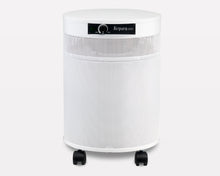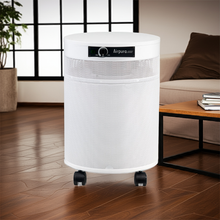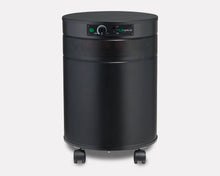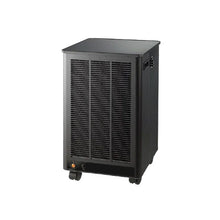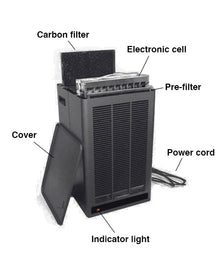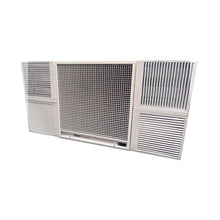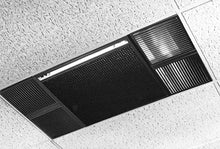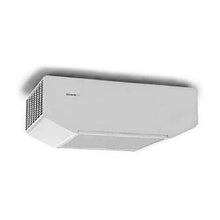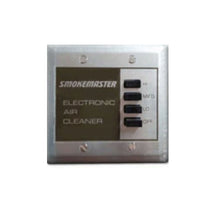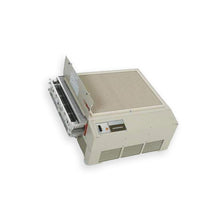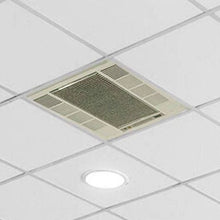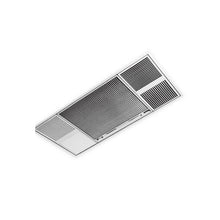Clearing the Air Actively: Advanced Commercial Air Purifiers for Eliminating Stubborn Cigarette & Vape Smoke

The lingering smell of stale cigarette smoke or the pervasive sweetness of vape clouds can instantly deter customers, diminish comfort, and, most importantly, pose serious health risks to occupants and staff. For businesses like bars, restaurants, vape shops, or even spaces with historical smoking residue, traditional ventilation or consumer-grade air purifiers simply aren't enough to tackle the complex chemical cocktail that constitutes smoke and aerosol.
At Commercial Air Purifiers, LLC, we understand that combating smoke and vape odors and particulates requires a specialized, robust approach. We're not just about filtering dust; we're about actively reclaiming indoor air quality, even in the most challenging environments. This is where a "cigarette smoke eliminator commercial" grade solution, a powerful "vape shop air purifier heavy use," or a dedicated "bar restaurant smoke eater" becomes not just an amenity, but a necessity. This comprehensive guide will explore the unique challenges posed by smoke and vape, delve into the advanced technologies that effectively eliminate them, and provide practical insights for businesses seeking to create truly clean and welcoming environments.
The Invisible Invader: Why Smoke and Vape are Such a Challenge
Cigarette smoke and vape aerosols are far more complex than simple airborne particles. They consist of a multifaceted blend of gases, volatile organic compounds (VOCs), and ultrafine particulate matter that can linger in the air for hours and settle on surfaces, creating "thirdhand smoke."
Cigarette Smoke: A Toxic Brew
Cigarette smoke contains over 7,000 chemicals, including hundreds that are toxic and at least 69 that are known to cause cancer. These include:
-
Ultrafine Particulates (PM2.5 and smaller): These microscopic particles are small enough to penetrate deep into the lungs and even enter the bloodstream, causing respiratory and cardiovascular diseases. The Centers for Disease Control and Prevention (CDC) consistently warns about the severe health risks of secondhand smoke, including heart disease, stroke, lung cancer, and exacerbated asthma in adults and children. Even brief exposure can damage blood vessels and increase the risk of heart attack.
-
Volatile Organic Compounds (VOCs): These are gases off-gassed from the smoke, contributing heavily to the persistent odor. Examples include benzene, formaldehyde, toluene, and ammonia – all harmful chemicals.
-
Nicotine Residue: Nicotine, while not the most harmful component, settles on surfaces, contributing to thirdhand smoke and a lingering, unpleasant odor.
-
Other Harmful Gases: Carbon monoxide, hydrogen cyanide, and various heavy metals are also present.
Vape Aerosol: A Misunderstood Threat
While often perceived as "harmless water vapor," vape aerosol is far from benign. It contains:
-
Ultrafine Particles: Similar to cigarette smoke, vape aerosol contains ultrafine particles that can be inhaled deeply into the lungs. The U.S. Surgeon General has concluded that e-cigarette aerosol is not harmless and can expose others to nicotine and other potentially harmful chemicals.
-
Flavoring Chemicals: Many e-liquids contain flavorings like diacetyl, which has been linked to severe lung disease (popcorn lung).
-
Heavy Metals: Studies have detected heavy metals like nickel, tin, and lead in vape aerosol, leached from the heating coils.
-
Formaldehyde and Acrolein: These are potent irritants and carcinogens formed when e-liquids are heated.
-
Nicotine: Most vape products contain nicotine, a highly addictive substance.
Both forms of smoke and vapor quickly saturate indoor air, settling on walls, furniture, and fabrics. This constant exposure not only creates an unwelcoming environment but also poses significant long-term health risks to customers and employees, necessitating a specialized "cigarette smoke eliminator commercial" grade solution.
The Science of Smoke Elimination: How Advanced Purifiers Work
To effectively combat cigarette and vape smoke, an air purification system must address both the particulate matter and the gaseous contaminants. This requires a multi-stage approach, often found in commercial-grade units.
1. Pre-filtration: Capturing the Bulk
The first line of defense is a robust pre-filter, often a MERV 8-10. This filter's primary job is to capture larger particles like dust, hair, and, crucially, some of the larger smoke particulates and tar. In environments with heavy smoke, specialized pre-filters known as "tar barriers" are often employed. These filters are designed to capture sticky tar and heavy smoke particles, protecting subsequent, more expensive filters and extending their lifespan.
-
Experience from Commercial Air Purifiers, LLC: We've observed that in high-volume settings like a busy "bar restaurant smoke eater" environment, frequent pre-filter changes are essential. Neglecting this step quickly clogs the more advanced filters, reducing efficiency and increasing operational costs. Regular maintenance is key to sustained performance.
2. True HEPA Filtration: Trapping the Microscopic Threats
The cornerstone of particulate removal in a "vape shop air purifier heavy use" or "cigarette smoke eliminator commercial" system is the True HEPA (High-Efficiency Particulate Air) filter.
-
How it Works: True HEPA filters are rigorously tested to capture 99.97% of airborne particles as small as 0.3 microns. This includes the vast majority of ultrafine particles found in cigarette smoke and vape aerosol, as well as pollen, pet dander, dust mites, mold spores, bacteria, and many viruses. HEPA filtration is a physical barrier that traps particles through a combination of interception, impaction, and diffusion.
-
Why it's Essential for Smoke: Without a True HEPA filter, microscopic smoke and vape particles would simply pass through less efficient filters and continue to circulate, settling on surfaces and being re-aerosolized.
3. Activated Carbon Filtration: The Odor and Gas Annihilator
While HEPA handles particulates, activated carbon is the undisputed champion for eliminating gases, odors, and VOCs – the primary culprits behind lingering smoke smells.
-
The Adsorption Process: Activated carbon is a highly porous material with millions of tiny pores that create an enormous surface area. Gases and odors are "adsorbed" onto this surface, meaning they chemically bond with the carbon. This is different from absorption, where a substance is taken into another.
-
Targeting Smoke & Vape Chemicals: For "cigarette smoke eliminator commercial" applications, specialized activated carbon (often impregnated with chemicals like potassium iodide or permanganate) is used. This enhanced carbon is designed to react with and neutralize a wider range of the specific VOCs and gaseous toxins found in tobacco smoke and vape aerosols, rather than just passively adsorbing them.
-
The Importance of Carbon Mass: Unlike consumer air purifiers that might contain a thin layer of carbon, a true "bar restaurant smoke eater" or "vape shop air purifier heavy use" unit will feature a substantial amount – often 10 to 40 pounds or more – of activated carbon. This mass is crucial for providing sufficient "dwell time" (the time gases spend in contact with the carbon) and capacity to effectively adsorb the heavy load of contaminants present in smoky environments. Our testing at Commercial Air Purifiers, LLC, has repeatedly shown that the quantity and quality of activated carbon are the most critical factors for odor elimination.
4. Optional Enhancements: UVC and Ionization (with caveats)
Some commercial air purifiers include additional technologies:
-
UVC Germicidal Lamps: Ultraviolet-C light can destroy airborne bacteria, viruses, and mold spores by disrupting their DNA/RNA. While primarily for biological contaminants, it can contribute to overall air hygiene.
-
Bipolar Ionization: This technology releases positively and negatively charged ions into the air that attach to particles, making them clump together and easier for filters to capture. It can also neutralize some VOCs and pathogens. However, it's crucial to choose ozone-free ionization to avoid generating harmful byproducts. The California Air Resources Board (CARB) certifies air purifiers that meet strict ozone emission limits.
Choosing the Right System: Specific Needs, Specific Solutions
Selecting the optimal "cigarette smoke eliminator commercial" solution requires careful consideration of the specific environment and the intensity of smoke/vape presence.
For Bars, Restaurants, and Lounges (Heavy Cigarette/Cigar Smoke)
These environments require the most robust solutions due to continuous, high-volume smoke generation.
-
Key Features:
-
High CFM: Sufficient Clean Air Delivery Rate (CADR) to achieve 6-10+ air changes per hour (ACH) depending on the density of smoking.
-
Massive Activated Carbon Bed: Minimum 20-30 lbs (or more) of specialty activated carbon, often impregnated for superior smoke VOC removal.
-
Durable Pre-filtration: Often featuring washable or easily replaceable "tar barrier" pre-filters to manage heavy particulate loads and protect the HEPA and carbon.
-
Robust Construction: Commercial-grade units are built to withstand continuous, heavy use.
-
-
Types:
-
Ceiling-Mounted Units: These "bar restaurant smoke eater" systems are popular as they are out of the way, often designed to blend with the decor, and can be wired directly into the electrical system for continuous operation. Examples like the Smokeeter® line or MatrixAir CeilingMount units are designed for this purpose, with some offering up to 1500 CFM or more.
-
Ducted Systems: For new constructions or major renovations, integrating a large commercial air purifier directly into the HVAC system can provide silent, whole-building filtration.
-
Large Portable Units: For smaller, dedicated smoking areas or as supplementary filtration, robust portable units with high CFM and carbon mass can be effective.
-
-
Case Study Insight: A client, "The Golden Lounge," a cigar bar in Minneapolis, struggled with smoke lingering for hours after closing, even with their existing ventilation. After installing ceiling-mounted "bar restaurant smoke eater" units from Commercial Air Purifiers, LLC, with specialized tar barriers and 25-pound activated carbon filters, they reported a dramatic improvement. "The air is clear within an hour of closing," the owner stated, "and the lingering stale smell is gone. Our staff and morning customers have noticed a huge difference." This validates our emphasis on high carbon mass for smoke.
For Vape Shops (Heavy Vape Aerosol Use)
While vape aerosol might have fewer direct combustion byproducts than cigarette smoke, the sheer volume of vapor, nicotine, and flavoring chemicals demands specialized filtration.
-
Key Features:
-
High CFM: Crucial for managing dense clouds and achieving rapid air changes.
-
Significant Activated Carbon: While perhaps not requiring the same type of impregnated carbon as cigarette smoke, a large volume (15-25 lbs) of activated carbon is still critical for adsorbing nicotine, propylene glycol, vegetable glycerin, and flavoring chemicals that contribute to lingering odors.
-
True HEPA Filtration: Essential for capturing the ultrafine particulate matter in the aerosol.
-
-
Types:
-
Floor-standing Commercial Units: Brands like Airpura (e.g., T600DLX, T700DLX models specifically for smoke/chemicals) or Medify Air (e.g., MA-112 with robust carbon) offer powerful portable solutions ideal for "vape shop air purifier heavy use." These units are designed to handle continuous operation in high-concentration environments.
-
Ducted/Integrated Solutions: For larger vape lounges, integration with the HVAC system offers the most comprehensive and discreet solution.
-
-
Experience from Commercial Air Purifiers, LLC: We've found that the "DLX" series from manufacturers, which emphasizes extra-deep activated carbon beds, often performs exceptionally well in vape shop environments, due to the high load of VOCs and other gaseous chemicals. The combination of HEPA for visible cloud removal and abundant carbon for chemical adsorption is paramount.
For Homes with Stubborn Cigarette Smoke Residue (Historical or Occasional Use)
Even if smoking no longer occurs, the "thirdhand smoke" residue embedded in surfaces can release odors and particles over time. For active smoking, a dedicated, high-capacity unit is essential.
-
Key Features:
-
Deep Activated Carbon Filters: For existing residue, a filter with substantial activated carbon is vital to "pull" the off-gassing odors from surfaces.
-
True HEPA: To capture any re-aerosolized particles.
-
Air Changes: Aim for 4-6 ACH for active smoking, and continuous lower-speed operation for residue removal.
-
-
Solutions:
-
Portable Commercial-Grade Units: For heavy or historical residue, a dedicated portable unit like the Austin Air Healthmate Plus™ (known for its substantial carbon) or the Airpura T600/700 series can be invaluable as a "cigarette smoke eliminator commercial" equivalent for residential use. These are designed to handle demanding air quality issues.
-
Whole-Home Integrated Systems: If active smoking occurs, integrating a system with robust HEPA and carbon into the HVAC can be the most effective long-term solution.
-
Conclusion: Creating Truly Clean Air Environments
Cigarette smoke and vape aerosols present complex air quality challenges due to their unique blend of gases, VOCs, and ultrafine particles. Generic air purifiers or inadequate ventilation simply cannot provide the comprehensive removal needed to safeguard health and maintain a welcoming atmosphere.
At Commercial Air Purifiers, LLC, we advocate for advanced, commercial-grade air purification systems specifically engineered to act as a potent "cigarette smoke eliminator commercial" solution, a reliable "vape shop air purifier heavy use" unit, or an indispensable "bar restaurant smoke eater." By investing in systems featuring robust pre-filtration, True HEPA filters, and, most critically, substantial beds of specialized activated carbon, businesses and homeowners can actively clear the air, eliminate stubborn odors, mitigate health risks, and create environments where patrons and occupants can breathe truly clean, fresh air. Don't compromise on air quality; the health and comfort of everyone in your space depend on it.
Frequently Asked Questions
Q1: Can a regular home air purifier eliminate cigarette smoke or vape odors?
A1: While some home air purifiers may offer a temporary reduction in light smoke or vape odors, they are generally not equipped to handle the heavy particulate and gaseous load associated with continuous or frequent smoking/vaping. They typically lack the substantial activated carbon mass and the high CFM needed for effective, continuous elimination. For true remediation, a "cigarette smoke eliminator commercial" or "vape shop air purifier heavy use" unit with commercial-grade filtration is required.
Q2: How often do filters need to be changed in a "bar restaurant smoke eater"?
A2: Filter change frequency depends heavily on the volume of smoke and usage. In a busy bar or restaurant, pre-filters (tar barriers) might need to be changed weekly or bi-weekly. Activated carbon filters, depending on their mass, could last anywhere from 3-12 months. HEPA filters typically last 1-3 years. Regular monitoring and adherence to manufacturer guidelines, adapted for your specific usage, are essential for optimal performance and cost-efficiency.
Q3: Are ozone generators effective for smoke removal, and are they safe?
A3: Ozone generators work by releasing ozone (O3), a powerful oxidant, to chemically react with and break down odor-causing molecules. While they can be effective at removing odors, ozone is a lung irritant and can be harmful to human health, especially for individuals with respiratory conditions. The EPA and health organizations advise against using ozone generators in occupied spaces. For continuous smoke elimination in commercial or residential settings, advanced filtration systems using HEPA and activated carbon are the recommended safe and effective solution.
Q4: Will a "vape shop air purifier heavy use" also help with general allergens?
A4: Absolutely. Since these commercial-grade systems utilize True HEPA filters, they are highly effective at capturing a wide range of airborne allergens such as pollen, pet dander, dust mite allergens, and mold spores. The robust airflow and multi-stage filtration designed for smoke and vape also make them excellent choices for comprehensive allergen removal, contributing to better overall indoor air quality.
About the Author: Commercial Air Purifiers, LLC is a leading provider of high-quality air purification solutions for commercial, industrial, and specialized residential environments. With years of experience and a deep understanding of airborne contaminants, we are dedicated to helping businesses and individuals achieve optimal indoor air quality. Our commitment to research-backed solutions and customer well-being drives our mission to bring the best air purifiers to the market.
Publication Date: July 19, 2025
References:
-
Centers for Disease Control and Prevention (CDC). (n.d.). Health Problems Caused by Secondhand Smoke. Retrieved from https://www.cdc.gov/tobacco/secondhand-smoke/health.html
-
Cleveland Clinic. (n.d.). Secondhand Smoke: Health Risks & Prevention. Retrieved from https://my.clevelandclinic.org/health/articles/10644-secondhand-smoke-dangers
-
American Cancer Society. (2024, November 19). Health Risks of Secondhand Smoke. Retrieved from https://www.cancer.org/cancer/risk-prevention/tobacco/secondhand-smoke.html
-
Environmental Protection Agency (EPA). (n.d.). Ozone Generators that are Sold as Air Cleaners: An Assessment of Health Effects. Retrieved from https://www.epa.gov/indoor-air-quality-iaq/ozone-generators-are-sold-air-cleaners-assessment-health-effects
-
Airpura Industries. (n.d.). Tobacco & Marijuana Smoke & Odor. Retrieved from https://www.airpura.com/collections/tobacco-marijuana-smoke-odor (Provides examples of high-carbon units for smoke/odor).
-
ISO-Aire. (n.d.). Air Purifier & Filtration Systems for Restaurants & Bars. Retrieved from https://www.iso-aire.com/restaurants-and-bars (Showcases commercial-grade systems for heavy use).

